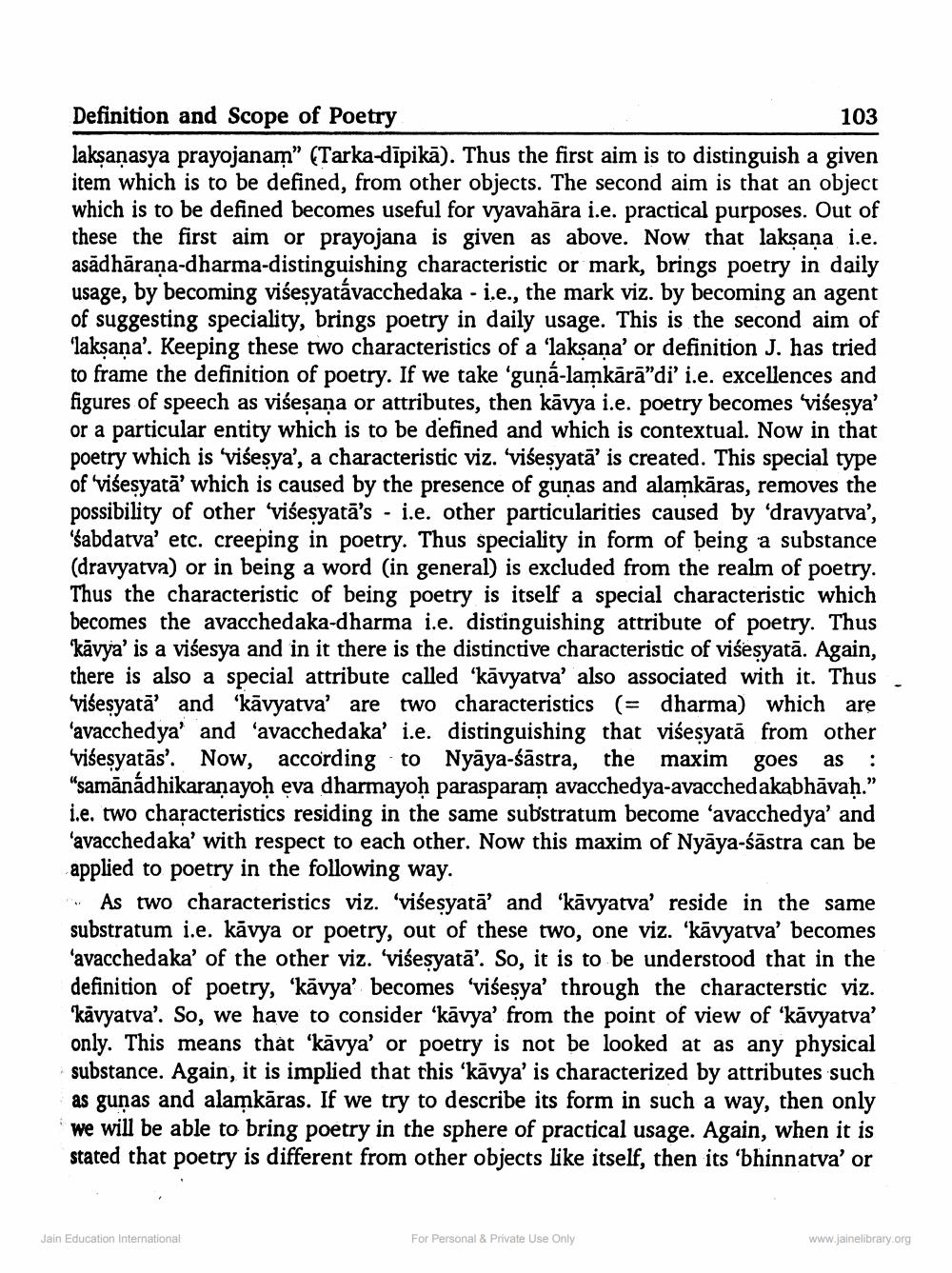________________
Definition and Scope of Poetry
103
laksanasya prayojanam" (Tarka-dīpikā). Thus the first aim is to distinguish a given item which is to be defined, from other objects. The second aim is that an object which is to be defined becomes useful for vyavahāra i.e. practical purposes. Out of these the first aim or prayojana is given as above. Now that laksana i.e. asādhāraṇa-dharma-distinguishing characteristic or mark, brings poetry in daily usage, by becoming viseșyatávacchedaka - i.e., the mark viz. by becoming an agent of suggesting speciality, brings poetry in daily usage. This is the second aim of 'laksana'. Keeping these two characteristics of a 'laksana' or definition J. has tried to frame the definition of poetry. If we take 'guņá-lamkārā”di' i.e. excellences and figures of speech as višeşana or attributes, then kāvya i.e. poetry becomes 'višesya' or a particular entity which is to be defined and which is contextual. Now in that poetry which is 'viśesya', a characteristic viz. 'viśesyatā' is created. This special type of 'višesyatā' which is caused by the presence of gunas and alamkāras, removes the possibility of other 'viśesyatā's - i.e. other particularities caused by 'dravyarva', Sabdatva' etc. creeping in poetry. Thus speciality in form of being a substance (dravyarva) or in being a word (in general) is excluded from the realm of poetry. Thus the characteristic of being poetry is itself a special characteristic which becomes the avacchedaka-dharma i.e. distinguishing attribute of poetry. Thus 'kávya' is a viśesya and in it there is the distinctive characteristic of visesyatā. Again, there is also a special attribute called 'kavyarva' also associated with it. Thus višesyatā' and 'kāvyatva' are two characteristics (= dharma) which are 'avacchedya' and 'avacchedaka' i.e. distinguishing that visesyatā from other 'viśesyatās'. Now, according to Nyāya-śāstra, the maxim goes as : "samānádhikaranayoh eva dharmayoh parasparam avacchedya-avacchedakabhāvah." i.e. two characteristics residing in the same substratum become 'avacchedya' and 'avacchedaka' with respect to each other. Now this maxim of Nyāya-śāstra can be applied to poetry in the following way.
As two characteristics viz. 'visesyatā' and 'kāyyatva' reside in the same substratum i.e. kavya or poetry, out of these two, one viz. 'kāvyatva' becomes 'avacchedaka' of the other viz. 'višesyatā'. So, it is to be understood that in the definition of poetry, 'kāvya' becomes 'višesya' through the characterstic viz. 'kävyatva’. So, we have to consider 'kavya' from the point of view of ‘kāvyatva'
. This means that 'kavya' or poetry is not be looked at as any physical substance. Again, it is implied that this 'kāvya' is characterized by attributes such as gunas and alamkāras. If we try to describe its form in such a way, then only We will be able to bring poetry in the sphere of practical usage. Again, when it is stated that poetry is different from other objects like itself, then its 'bhinnatva' or
Jain Education International
For Personal & Private Use Only
www.jainelibrary.org




